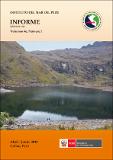Por favor, use este identificador para citar o enlazar este ítem:
https://hdl.handle.net/20.500.12958/3344| Título : | Concha negra Anadara tuberculosa (Sowerby, 1833) y concha huequera Anadara similis (C. B. Adams, 1852) en los manglares de Tumbes. Julio 2016 |
| Otros títulos : | Black ark Anadara tuberculosa (Sowerby, 1833) and brown ark Anadara similis (C. B. Adams, 1852) in the Tumbes mangroves. July 2016 |
| Autor : | Alemán Mejía, Solange Alexander Ordinola Zapata, Elmer Montero, Percy |
| Palabras clave : | Anadara tuberculosa;Anadara similis;densidad;biomasa;Talla;Leukoma asperrima;Mytella guyanensis;Thaisella kiosquiformis;Crepidula sp. |
| Fecha de publicación : | 2019 |
| Editorial : | Instituto del Mar del Perú |
| Citación : | Inf Inst Mar Perú 46(2), 2019, p.279-292 |
| Citación : | Informe IMARPE;46(2), 2019 |
| Resumen : | La
prospección biológica poblacional de ambos recursos en los manglares de Tumbes se efectuó en julio 2016.
Densidad media de concha negra fue 1,0 ind.m-2, mayor valor (1,4 ind.m-2) en Puerto Pizarro y menor (0,2
ind.m-2) en Corrales; densidad media de concha huequera fue 0,4 ind.m-2. Biomasa media de concha negra
fue 17,2 g.m-2, mayor valor (22,5 g.m-2) en Puerto Pizarro y menor (4,6 g.m-2) en Corrales; la biomasa media
de concha huequera fue 5,1 g.m-2, el mayor valor en la zona centro (7,5 g.m-2). La talla en concha negra varió
entre 4 y 62 mm de longitud valvar (LV) con media en 39,2 mm; 21% de ejemplares estuvo en talla comercial
(≥45 mm LV). La talla media de concha huequera fue 38,9 mm LV; el 32,1% estuvo en talla comercial. La
proporción sexual de A. tuberculosa favoreció a hembras, predominaron hembras desarrolladas y machos
en desarrollo; en A. similis no presentaron diferencias y predominaron hembras maduras y machos en
desarrollo. La macrofauna asociada estuvo representada por siete especies de moluscos destacando concha
blanca (Leukoma asperrima), choro o mejillón (Mytella guyanensis), Thaisella kiosquiformis y Crepidula sp. La
densidad y biomasa de la especie competidora L. asperrima fueron de 1,5 ind.m-2 y 21,4 g.m-2. ABSTRACT: The biological population prospecting of both resources in the Tumbes mangroves was carried out in July 2016. The mean density of black ark was 1.0 ind.m-2, the highest value (1.4 ind.m-2) was found in Puerto Pizarro and the lowest (0.2 ind.m-2) in Corrales; the mean density of brown ark was 0.4 ind.m-2. The mean biomass of black ark was 17.2 g.m-2, the highest value (22.5 g.m-2) was recorded in Puerto Pizarro and the lowest (4.6 g.m-2) in Corrales; the mean biomass of A. tuberculosa was 5.1 g.m-2, the highest value in the central zone (7.5 g.m-2). The length in black ark ranged from 4 to 62 mm in valvar length (VL) with a mean of 39.2 mm; a total of 21% of specimens were in commercial size (≥45 mm VL). The mean size of brown ark was 38.9 mm VL; only 32.1% were in commercial size. The sex ratio of A. tuberculosa favored females, with developed females and developing males predominating; in A. similis there were no differences and mature females and developing males predominated. The associated macrofauna was represented by seven species of mollusks, with the predominance of the Venus clam (Leukoma asperrima), mangrove mussel (Mytella guyanensis), Thaisella kiosquiformis, and Crepidula sp. The density and biomass of the competing species L. asperrima were 1.5 ind.m-2 and 21.4 g.m-2, respectively. |
| URI : | https://hdl.handle.net/20.500.12958/3344 |
| Aparece en las colecciones: | Informe vol. 46(2) 2019 |
Ficheros en este ítem:
| Fichero | Descripción | Tamaño | Formato | |
|---|---|---|---|---|
| Informe 46-5.pdf | 20,71 MB | Adobe PDF |  Visualizar/Abrir |
Este ítem está sujeto a una licencia Creative Commons Licencia Creative Commons

